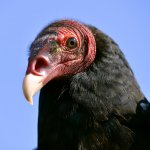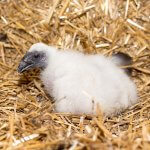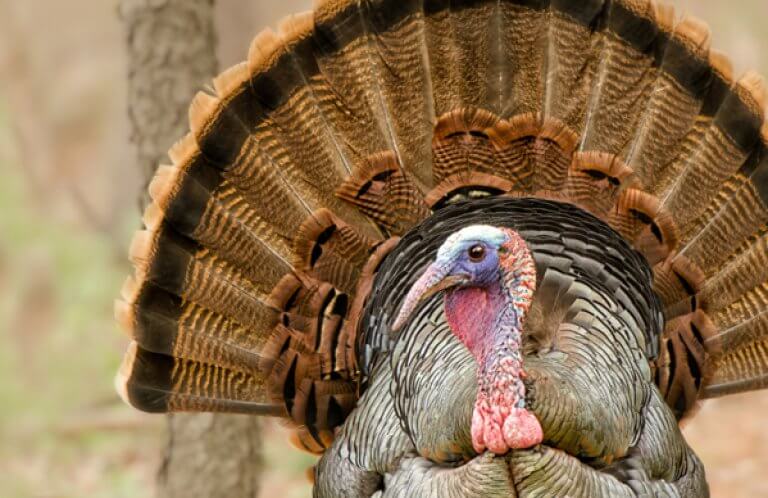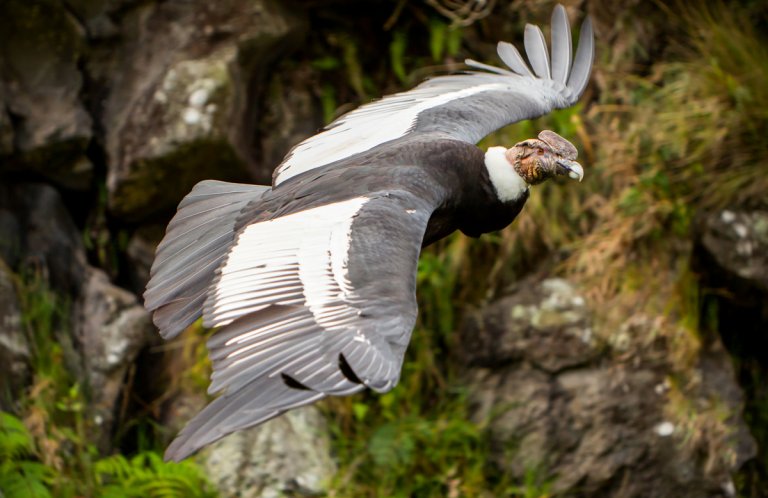About the Turkey Vulture
The Turkey Vulture is North America's most frequently seen soaring bird. One of the best ways to start learning raptors in flight is to first peg identification of this species. Long-tailed and looming, the Turkey Vulture circles overhead on two-toned wings held in a shallow V, seldom flapping but often rocking slightly side to side. Seen in good light, this is the only raptor with a red head. On the ground, it is easy to mistake this very large, dark vulture for a Wild Turkey. Thus, the name.
Two other vultures occur in the U.S. and Canada — the Black Vulture and the Critically Endangered California Condor. The first is smaller and the second far larger than the Turkey Vulture, yet both species can out-muscle it for carrion, as do other species, including King Vultures (in the tropics) and Red-tailed Hawks.
The Olfactory Factor
Black Vultures and California Condors rely on their eyesight to spot carrion, but Turkey Vultures both watch and smell their way to meals. Compared with most other vultures, Turkey Vultures have much-enlarged olfactory bulbs that give them a super-keen sense of smell, which they tap to locate carcasses other birds miss. But competitors are always watching: In areas where both Black and Turkey Vultures occur, the smaller Black Vulture often follows Turkey Vultures to meals, then crowds out the larger bird. Some research indicates Turkey Vultures may favor smaller carcasses, which they can consume quickly after arriving on the scene. Turkey Vultures also step aside for the far-larger California Condor, but benefit when it's their turn because the rare giant can tear open tough skin its smaller cousin cannot. A similar arrangement occurs in South America, where King Vultures or Andean Condors "rule the roost."
Songs and Sounds
Birders rarely hear Turkey Vultures make sounds, other than, if birds are close by, the flapping of the large bird's wings, or wind rushing through them. Turkey Vultures do sometimes vocalize, though: When scuffling over food, or at the nest site, they may hiss. They also make clucking and wheezing sounds.
Breeding and Feeding
Dark Nursery
Turkey Vultures don't make a formal nest, but rather the female usually lays two eggs (each approximately the size of a chicken egg) in a dark location. In the West, this bird usually nests in rocky locations — on cliffs, in caves, or among large boulders. In the East, nests may be in rocky areas, in thickets, in large tree cavities, on large logs or stumps, or in brush piles. Sometimes, Turkey Vultures nest atop abandoned hawk nests or in vacant buildings, or even in junked cars. One thing these varied nesting situations have in common: Turkey Vultures usually choose places far from regular human activity.
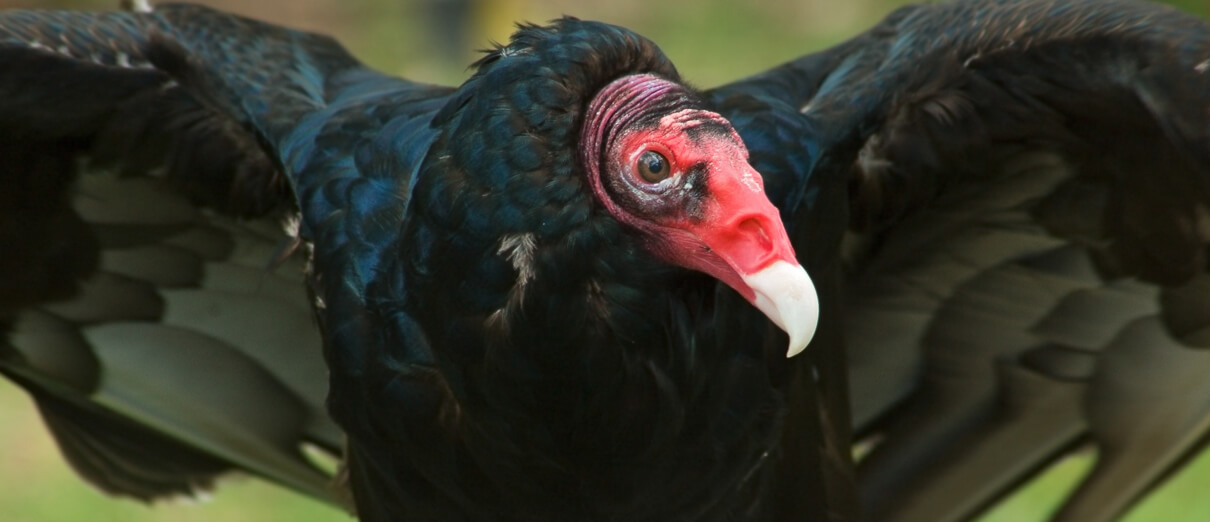
At the dark, quiet nest site, both parents take turns incubating the eggs for 30 to 40 days. Once they hatch, nestlings receive regurgitated meals from their parents. It takes nine to ten weeks (rarely, as few as six) for young to be able to fly.
Fresh Carrion
Turkey Vultures feed almost entirely on carrion, with a noted preference for "fresher" finds. Many of their meals are mammalian, from dead mice to cattle, but they also eat dead invertebrates, fish, amphibians, and reptiles. In times of shortage, they may eat some rotting vegetation. On rare occasions, Turkey Vultures eat live prey, such as trapped small mammals, insects, or minnows stranded in drying pools.
Region and Range
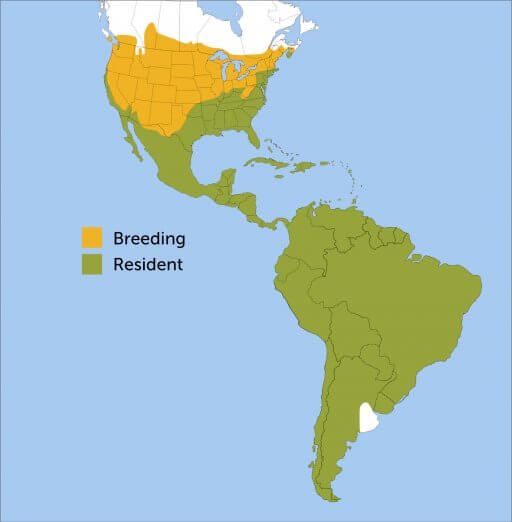
The Turkey Vulture frequents open areas, including pastures, deserts, grasslands, shorelines, open forest, roadsides, and trash dumps — almost anywhere there may be carrion or trash left in the open. It usually roosts and nests in wooded areas or other out-of-reach outposts like cliffs or tall towers or buildings.
The Turkey Vulture nests from southern Canada to South America's southern tip in Tierra del Fuego. It also nests on many islands, including those in the northern Caribbean and in the Falklands.
This vulture is present year-round across much of its expansive range, with the exception of Canada and many northern and inland U.S. states, which are vacated in fall, until birds return in February or March. During migration, large numbers of Turkey Vultures pass over concentration points. For example, on average, 1.5 million are tallied over Veracruz, Mexico each fall.
Conservation
In recent decades, Turkey Vulture populations have grown in many areas. The species' breeding and wintering ranges have expanded as well. Population estimates are not available for Central and South America, but these birds remain widespread and common across their range.
Turkey Vultures do face some widespread threats. Lead poisoning is one of the greatest: When feeding on dead animals such as deer killed by lead shot, the birds often suffer the effect of the toxins within the meat they eat. Turkey Vultures also are killed or injured by leg-hold traps set to catch mammals.
Although most people understand and appreciate the natural cleaning services performed by vultures and other scavengers, Turkey Vultures are still sometimes killed due to unwarranted fears that they spread disease to livestock, or because they are mistakenly believed to be a threat to young livestock.
Get Involved
Policies enacted by the U.S. Congress and federal agencies, such as the U.S. Fish and Wildlife Service, have a huge impact on migratory birds. You can help shape these rules for the better by telling lawmakers to prioritize birds, bird habitat, and bird-friendly measures. To get started, visit ABC's Action Center.
Living a bird-friendly life can have an immediate impact on migratory birds in the United States. Doing so can be as easy as adding native plants to your garden, avoiding pesticides, and keeping cats indoors. To learn more, visit our Bird-Friendly Life page.
American Bird Conservancy and our Migratory Bird Joint Venture partners have improved conservation management on more than 8.5 million acres of U.S. bird habitat — an area larger than the state of Maryland — over the last ten years. That's not all: With the help of international partners, we've established a network of more than 100 areas of priority bird habitat across the Americas, helping to ensure that birds' needs are met during all stages of their lifecycles. These are monumental undertakings, requiring the support of many, and you can help by making a gift today.






































